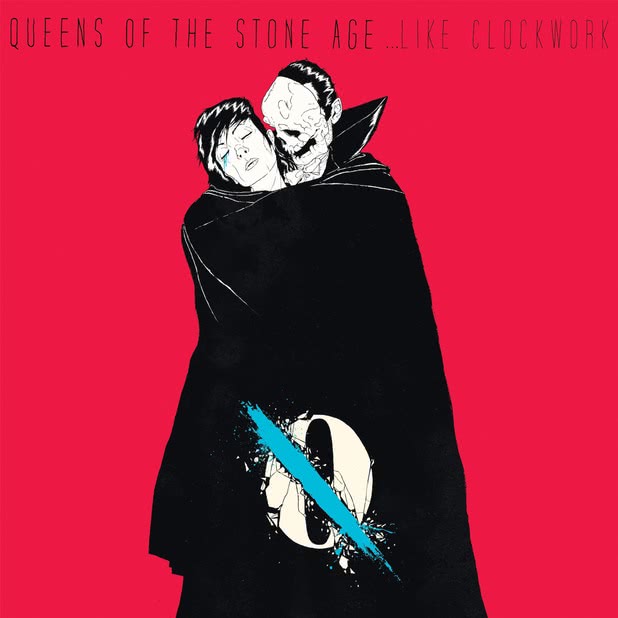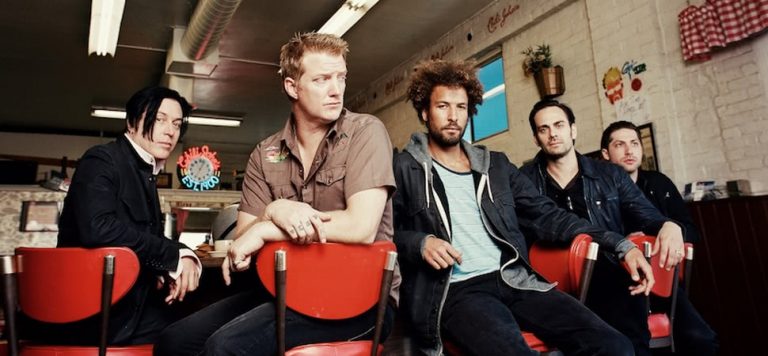Queens of the Stone Age are indisputably one of the greatest bands to ever exist, and their discography is more than able to back up this claim. It’s possibly one of the tightest, most compelling assortments of records to have been released by a single band.
Having said that, with the news that their new record is almost done and dusted, we’ve decided to take on the impossible task of ranking their discography from worst to best.
We have to stress just how inappropriate the word ‘worst’ is in the context of a band like QOTSA and, with everyone in the office being a passionate fan, it turned into a pretty long discussion. In the end, though, we managed to agree on the following list.
Here’s our ranking of the Queens of the Stone Age discography.
Era Vulgaris (2007)

Hey, like we said, all of QOTSA’s albums are great, but we had to kick off the list somehow and it’s not like we were ever hoping to make any friends with a feature like this. For some reason, Era Vulgaris seems to be the runt of the litter. It’s up for debate, but when we did a quick tally around the office and amongst our mates, Era Vulgaris was most consistently ranked as the least favourite Queens of the Stone Age album.
It’s a shame, really. The reviews of the album were lukewarm, but QOTSA never made albums to garner the adulation of Pitchfork writers. So why did they make Era Vulgaris? As JG Ballard once put it, “to rub the human face in its own vomit and force it to look in the mirror”.
Era Vulgaris is like Mike Judge’s Idiocracy if it was an album instead of a movie. On ‘Turnin’ on the Screw’, a chorus of Hommes caution, “You ain’t a has-been if you never was.” On ‘I’m Designer’, he declares, “The thing that’s real for us is fortune and fame / All the rest seems like work“.
The album was quirky, eclectic, and suffered from a severe case of multiple personality disorder. It’s like flipping through channels and they’re all tuned to Sick Sad World. But we urge any of its detractors to give it another chance because, while its lack of cohesion and oft-grating nature may leave it at the bottom of the pack, there’s still plenty of majesty in the madness.
Queens of the Stone Age (1998)

Is QOTSA’s self-titled debut a bad album? You watch your mouth. Is it one of QOTSA’s weaker efforts? Let’s discuss.
Queens of the Stone Age wasn’t a QOTSA album in the same way that the other records on this list are, in which Homme assembles his band of merry men and women and gets to work. It’s Homme, ex- of Kyuss, figuring out what he’s going to do with the rest of his life.
There’s shadows of what QOTSA would eventually become, but the album is really Homme taking an idea and running with it into the night. It’s still steeped in many of the conventions of the scene Homme came up in and, whilst songs like ‘How to Handle a Rope’ and ‘Regular John’ are immortal, this statement of raw intent ultimately only hints at the greatness yet to come.
Rated R (2000)

If the self-titled debut was Homme playing town cryer and announcing the dawn of a new era, Rated R was Queens of the Stone Age, now a full-fledged band, setting out their five-point plan for what that new era would look like and where it could take us.
Where the debut was Homme fleshing out an embryonic idea, Rated R was a fully formed demon spawn. An infernal Damien ready to wreak havoc and do it all with a shit-eating smirk on its face.
Rated R was Homme, bassist Nick Oliveri, and their cast of guest collaborators putting the dick jokes back in rock and roll. The same year Radiohead twisted everyone’s melons with Kid A, QOTSA reminded everyone that rock is meant to be fun. It’s meant to be funny. Damn it, it’s meant to be sexy.
Many now dismiss ‘Feel Good Hit of the Summer’ as a juvenile piece of cock rock that only 14-year-olds who still think its transgressive to say ‘marijuana’ in a song could enjoy. But to release a shopping list of drugs as the big single (no, not the lead) on your major label debut? That takes balls, and humour.
Lullabies to Paralyse (2005)

The thing about all the other albums on this list is that they all serve a purpose. Queens of the Stone Age was the band kicking down the door and Rated R was them stepping inside and promptly setting up a meth lab.
Era Vulgaris was the band holding up a mirror to the face of society and …Like Clockwork was Homme taking that mirror and turning it on himself. Songs for the Deaf, well, Songs for the Deaf is Queens of the Stone Age.
But Lullabies to Paralyse is this album that’s kind of sandwiched between Songs for the Deaf and Era Vulgaris. It’s not really trying to say anything or communicate a particular message. It just sort of is, which is to say it’s awesome.
Lullabies to Paralyse is Homme assembling his troops and getting to work. Sometimes, you just want to write some songs and play some music. It’s what Homme does. It’s not an existential epic like the next album on this list.
There’s no near-death experience, narrative concept, or disgust with modern society to inspire and propel the songs. It’s QOTSA when they simply clock in and get down to business, and in that sense it’s almost bafflingly good.
…Like Clockwork (2013)

“It was a tough time and I thought, ‘I can run away from this, or I can run into it,'” Homme once said of QOTSA’s 2013 album, which many have since hailed as perhaps the band’s magnum opus, Homme’s most confessional and personal testament to date, and their vie for artistic respectability.
You know in movies when a bomb goes off and everything’s in slow motion and there’s just a ringing tone everywhere? …Like Clockwork is that feeling set to music, coming after Homme’s near-death experience during surgery and a period of severe depression.
As always, music was the healer and Homme decided to make the follow-up to Era Vulgaris a complete and total curve ball, unlike anything else in the band’s discography.
Sure, ‘Smooth Sailing’ still struts like a peacock and ‘My God Is the Sun’ has a coiling riff as good as anything on Songs for the Deaf or Rated R, but …Like Clockwork is, for lack of a better term, epic.
Like all great art, it takes the personal and blows it up to colossal proportions on a cosmic silver screen and lets it play out in front of you. Subtle, brooding, and thoughtful, yet somehow still sly, sexy, and seductive.
Songs for the Deaf (2002)

What more can you say about Songs for the Deaf that hasn’t already been said? Queens of the Stone Age’s third studio effort is a modern classic, the album that even helped your dad feel like guitar music might still have a chance in the new millennium.
Inspired by the drive through the California desert from Los Angeles to Joshua Tree, Songs for the Deaf is a loose concept album peppered with radio noise and tongue-in-cheek skits from fake radio announcers who guide you through the album.
Songs for the Deaf was Homme and Oliveri taking all the dinosaur bones they’d unearthed on the previous two records and flicking a match into the gas tank. Speaking of horsepower, Dave Grohl is a revelation on the drum kit.
Already firmly established as one of the best and most powerful drummers of his generation, the meaty punch of the beats on Songs for the Deaf is what we imagine a right hook to the face from Brock Lesnar might feel like.
If somebody’s unsure of whether they’ll enjoy Queens of the Stone Age, give them Songs for the Deaf. If they’re not on board by the time ‘Do It Again’ rolls around, there’s no hope for them. Songs for the Deaf is a shot of pure QOTSA straight to the heart.




































